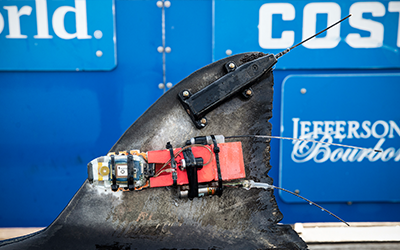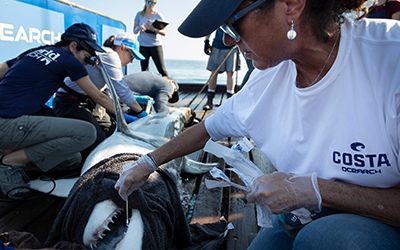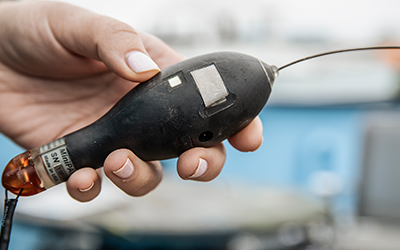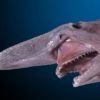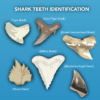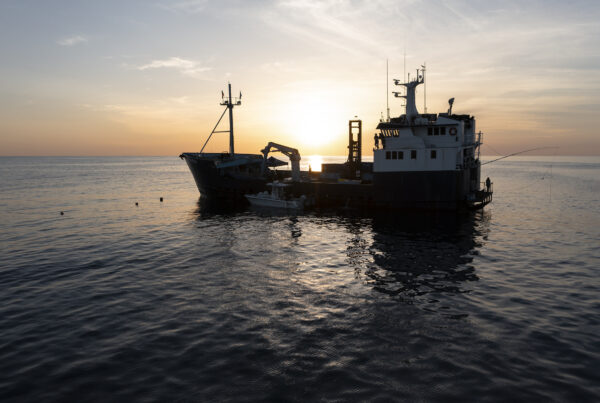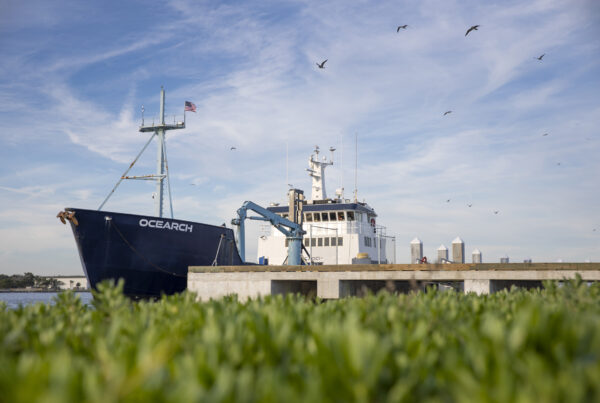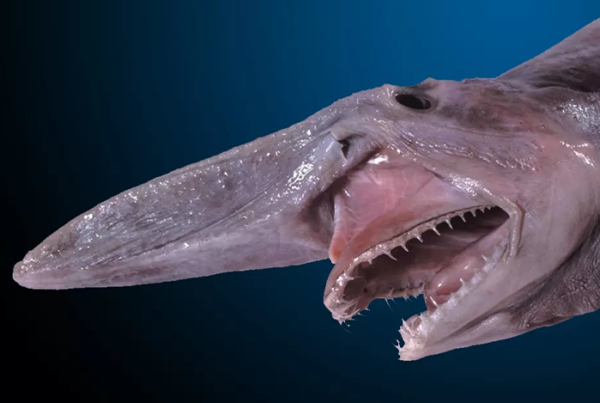Samples
1. Measurements
We take up to 7 measurements of each of our sharks: girth, pre-caudal length, fork length, total length, stretch total length, and the inner and outer clasper lengths in male animals. The different lengths help us estimate the age of the shark and we use these to assign the age classes you see on the tracker. Here we are taking the stretch total length of male white shark Tancook.

2. Ultrasound
Ultrasound exams are performed as part of projects that study the white shark reproductive cycle, normal heart structure and physiology, and the overall health of the sharks we tag, sample, and release. The OCEARCH’s specialized lift makes it much easier to use this portable technology to perform complete exams than those performed boatside with the animals still in the water.
During each ultrasound exam researchers assess the size and activity of the ovary or testis, whether the uterus is developed or potentially contains pups, whether the ampulla (a storage area for semen in male sharks) is full, and also document multiple contractions of the heart, the density of the liver, and the contents of the spiral intestine and coelom. These studies help us understand what age and during what season white sharks are reproductively active, how fast and complete heart contractions are when the white sharks are on the lift, and record baselines of comparison for the other health studies. These studies could also detect illness if it is present in an individual shark.


3. Blood
We collect blood samples from each shark we study, and they are the samples most used out of our 24 unique research projects. Blood samples allow us to investigate each shark’s overall systemic health, nutritional health and the shark’s diet, primary stress and reproductive hormone levels,, exposure to heavy metals and other toxins, and blood gases and metabolite changes during handling.
4. Muscle
The second most commonly used sample for the 24 projects in the Western North Atlantic white shark study is muscle. Similar to blood this sample is used for a number of different studies including genetics, understanding the white shark diet including where they forage for prey species, and documenting exposure to heavy metals and other toxins. These results in conjunction with other studies help us better understand how the Western North Atlantic white shark population is related to other populations, what types of prey they rely on in different regions, and whether the toxins they are exposed to impact the sharks’ overall health.

5. Feces
Fecal samples help give us insight on what the shark is feeding on, the presence of microplastics in their diet, and the bacteria living in their digestive tract. This sample has given us a better understanding of the prey species these sharks rely on in different regions and has shown that microplastics are present in every white shark we’ve studied.
6. Fin Clip
We clip a small, thin sample of a white sharks’ fin, typically the second dorsal or anal fin, which allows us to analyze its DNA and study the genetics of the animal. This will show us if any of our sharks tagged in the Western North Atlantic are related as well as help us understand their relation to white shark populations in other regions.

7. Semen in males
An important question we are trying to answer about the white shark in the Western North Atlantic is when and where these animals are mating. One thing that helps us answer this is a semen sample from the adult males. Analyzing this sample and seeing the motility of the sperm allows us to better understand the male shark’s reproductive readiness.
Tags
1. SPOT Tag
A SPOT Tag, or Smart Position and Temperature Transmitting Tag, allows us to follow individual sharks in near real time. We attach these tags to the shark’s first dorsal fin and the tag transmits a locating signal, or “ping,” when the shark’s fin remains above the water’s surface for a brief period as the animal swims. These tags allow you to learn alongside our science team when you visit the OCEARCH Global Shark Tracker to follow their movements.
2. PSAT Tag
We utilize PSAT or Pop-up Satellite Archival tags to help us better understand sharks vertical and horizontal movements, temperature preferences and critical habitats of a shark. After we attach this tag to a shark, we typically program it to detach from the shark and pop up after one year. Once at the water’s surface, the PSAT transmits a summary of the data archived over the past year, giving scientists insight into where the shark has traveled and how this animal spent its time below the surface.
3. Acoustic Tag
In addition to SPOT tags we implant acoustic tags in the animals we study, allowing us to track their movements for up to 10 years. Utilizing underwater receivers listening for these tags’ signals in many parts of the ocean, we are able to get a location reading each time an acoustically tagged animal swims within range. However, we do not receive these locations in real time but instead utilize networks to collaborate with other scientists in order to collect this movement data after the fact. It can take a year or more to receive the data from these acoustic networks. It can take a year or more to receive the data from these networks but these long term tags provide another layer of valuable location information.
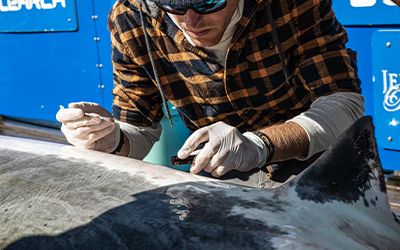
4. Biologger Packages
Biologger packages are placed on the shark’s dorsal fin, allowing us to understand more on the behavior of the animal by precisely recording their body movements, speed, and other variables. The packages may contain an accelerometer, a velocimeter, a camera, a small sonar unit, or a combination of any of these devices. After a set amount of time on the shark, typically less than 48 hours, the biologger automatically detaches from the shark and floats to the surface. Our team then must physically recover the biologger unit in order to download all the data that was collected. Each detached biologger has a transmitter that allows the team to home in on its location at the water’s surface.
